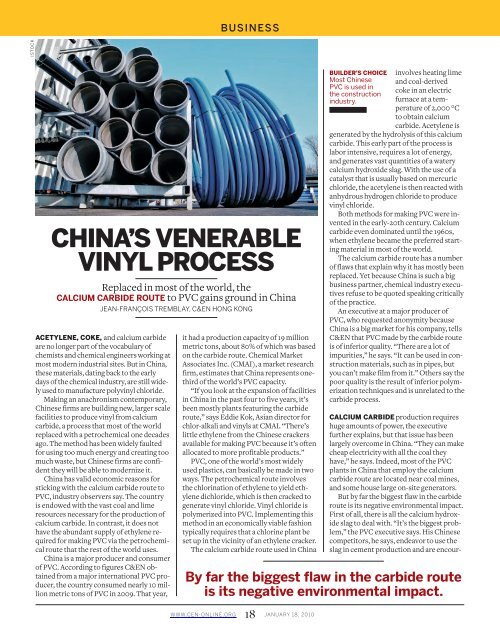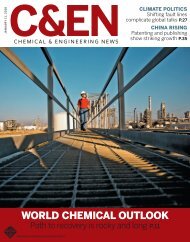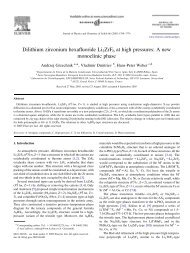Chemical & Engineering News Digital Edition - January 18, 2010
Chemical & Engineering News Digital Edition - January 18, 2010
Chemical & Engineering News Digital Edition - January 18, 2010
Create successful ePaper yourself
Turn your PDF publications into a flip-book with our unique Google optimized e-Paper software.
ISTOCK<br />
ACETYLENE, COKE, and calcium carbide<br />
are no longer part of the vocabulary of<br />
chemists and chemical engineers working at<br />
most modern industrial sites. But in China,<br />
these materials, dating back to the early<br />
days of the chemical industry, are still widely<br />
used to manufacture polyvinyl chloride.<br />
Making an anachronism contemporary,<br />
Chinese firms are building new, larger scale<br />
facilities to produce vinyl from calcium<br />
carbide, a process that most of the world<br />
replaced with a petrochemical one decades<br />
ago. The method has been widely faulted<br />
for using too much energy and creating too<br />
much waste, but Chinese firms are confident<br />
they will be able to modernize it.<br />
China has valid economic reasons for<br />
sticking with the calcium carbide route to<br />
PVC, industry observers say. The country<br />
is endowed with the vast coal and lime<br />
resources necessary for the production of<br />
calcium carbide. In contrast, it does not<br />
have the abundant supply of ethylene required<br />
for making PVC via the petrochemical<br />
route that the rest of the world uses.<br />
China is a major producer and consumer<br />
of PVC. According to figures C&EN obtained<br />
from a major international PVC producer,<br />
the country consumed nearly 10 million<br />
metric tons of PVC in 2009. That year,<br />
BUSINESS<br />
CHINA’S VENERABLE<br />
VINYL PROCESS<br />
Replaced in most of the world, the<br />
CALCIUM CARBIDE ROUTE to PVC gains ground in China<br />
JEAN-FRANÇOIS TREMBLAY , C&EN HONG KONG<br />
it had a production capacity of 19 million<br />
metric tons, about 80% of which was based<br />
on the carbide route. <strong>Chemical</strong> Market<br />
Associates Inc. (CMAI), a market research<br />
firm, estimates that China represents onethird<br />
of the world’s PVC capacity.<br />
“If you look at the expansion of facilities<br />
in China in the past four to five years, it’s<br />
been mostly plants featuring the carbide<br />
route,” says Eddie Kok, Asian director for<br />
chlor-alkali and vinyls at CMAI. “There’s<br />
little ethylene from the Chinese crackers<br />
available for making PVC because it’s often<br />
allocated to more profitable products.”<br />
PVC, one of the world’s most widely<br />
used plastics, can basically be made in two<br />
ways. The petrochemical route involves<br />
the chlorination of ethylene to yield ethylene<br />
dichloride, which is then cracked to<br />
generate vinyl chloride. Vinyl chloride is<br />
polymerized into PVC. Implementing this<br />
method in an economically viable fashion<br />
typically requires that a chlorine plant be<br />
set up in the vicinity of an ethylene cracker.<br />
The calcium carbide route used in China<br />
WWW.CEN-ONLINE.ORG <strong>18</strong> JANUARY <strong>18</strong>, <strong>2010</strong><br />
BUILDER’S CHOICE<br />
Most Chinese<br />
PVC is used in<br />
the construction<br />
industry.<br />
involves heating lime<br />
and coal-derived<br />
coke in an electric<br />
furnace at a temperature<br />
of 2,000 °C<br />
to obtain calcium<br />
carbide. Acetylene is<br />
generated by the hydrolysis of this calcium<br />
carbide. This early part of the process is<br />
labor intensive, requires a lot of energy,<br />
and generates vast quantities of a watery<br />
calcium hydroxide slag. With the use of a<br />
catalyst that is usually based on mercuric<br />
chloride, the acetylene is then reacted with<br />
anhydrous hydrogen chloride to produce<br />
vinyl chloride.<br />
Both methods for making PVC were invented<br />
in the early-20th century. Calcium<br />
carbide even dominated until the 1960s,<br />
when ethylene became the preferred starting<br />
material in most of the world.<br />
The calcium carbide route has a number<br />
of flaws that explain why it has mostly been<br />
replaced. Yet because China is such a big<br />
business partner, chemical industry executives<br />
refuse to be quoted speaking critically<br />
of the practice.<br />
An executive at a major producer of<br />
PVC, who requested anonymity because<br />
China is a big market for his company, tells<br />
C&EN that PVC made by the carbide route<br />
is of inferior quality. “There are a lot of<br />
impurities,” he says. “It can be used in construction<br />
materials, such as in pipes, but<br />
you can’t make film from it.” Others say the<br />
poor quality is the result of inferior polymerization<br />
techniques and is unrelated to the<br />
carbide process.<br />
CALCIUM CARBIDE production requires<br />
huge amounts of power, the executive<br />
further explains, but that issue has been<br />
largely overcome in China. “They can make<br />
cheap electricity with all the coal they<br />
have,” he says. Indeed, most of the PVC<br />
plants in China that employ the calcium<br />
carbide route are located near coal mines,<br />
and some house large on-site generators.<br />
But by far the biggest flaw in the carbide<br />
route is its negative environmental impact.<br />
First of all, there is all the calcium hydroxide<br />
slag to deal with. “It’s the biggest problem,”<br />
the PVC executive says. His Chinese<br />
competitors, he says, endeavor to use the<br />
slag in cement production and are encour-<br />
By far the biggest flaw in the carbide route<br />
is its negative environmental impact.




